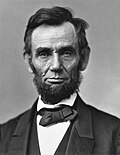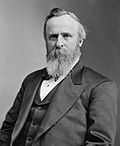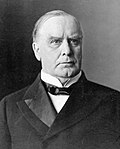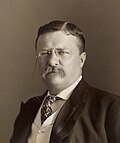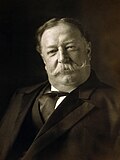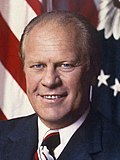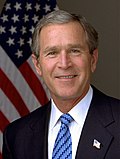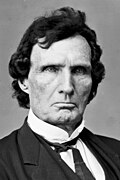Republican Party (United States)
The Republican Party, also known as the Grand Old Party (GOP) is one of the two biggest political parties in the United States. Since the mid-1850's, the party's main opponent has been the Democratic Party. Both political parties have controlled American politics ever since. The party sits at the right-wing of the American political spectrum, with the Democratic Party being positioned to their left. However, there also factions of the Republican Party that are center-right to far-right.
 | |
| U.S. President | Donald Trump |
| U.S. Vice President | JD Vance |
| Senate Majority Leader | John Thune |
| Speaker of the House | Mike Johnson |
| House Majority Leader | Steve Scalise |
| Merger of | Whig Party[1][2][3][4] Free Soil Party[5] Anti-Nebraska movement[6] |
| Headquarters | 310 First Street SE, Washington, D.C., U.S. |
| Student wing | College Republicans High School Republican National Federation |
| Youth wing | |
| Women's wing | National Federation of Republican Women |
| Overseas wing | Republicans Overseas |
| Ideology | Factions: |
| Political position | Right-wing[11] |
| International affiliation | |
| Caucuses | Republican Governance Group Republican Main Street Caucus Republican Study Committee Freedom Caucus |
| Colors | Red |
| Senate | 53 / 100 |
| House of Representatives | 220 / 435 |
| State governors | 27 / 50 |
| State upper chambers | 1,121 / 1,973 |
| State lower chambers | 2,985 / 5,413 |
| Territorial governors | 3 / 5 |
| Territorial upper chambers | 15 / 97 |
| Territorial lower chambers | 9 / 91 |
| Election symbol | |
 | |
| Website | |
{{URL|example.com|optional display text}} | |
^ A: Includes Trumpism.[15][16][17] | |
Ideologically, Republicans favor fiscal and social conservatism.[20] It opposes single-payer healthcare, abortion,[21] euthanasia, labor unions, affirmative action,[22] marijuana legalization, gay marriage and a high minimum wage.[23] It advocates for low taxes,[24] limited government,[25] gun rights,[26] free markets, traditional values and free trade.[27] It did, however, hold protectionist opinions during its early days,[28] for example during Theodore Roosevelt’s presidency. It also held anti-free trade opinions during Donald Trump’s presidency.[29]
The symbol of the Republican party is the elephant. This symbol was first used in 1874 in a political cartoon by Thomas Nast.[30] The Republican National Committee, or the RNC, is the main organization for the Republican Party in all 50 states. The Republican Party is not the same political party as the Democratic-Republican Party. A state where most voters vote for Republican politicians is called a red state.
History
The Republican Party was founded in Ripon, Wisconsin in 1853,[31] with the help of Francis Preston Blair. The Republican Party was formed by people who did not like the Kansas-Nebraska Act of 1854, which would let each territory allow slavery. The Republican Party was founded by past members of the Free Soil Party and the Whig Party who wanted to stop the expansion of slavery. The founders of the Republican Party wanted to stop the expansion of slavery because they believed it was against the ideals of the Constitution and Declaration of Independence. Some founders of the Republican Party wanted to abolish slavery everywhere in the United States. The Republican Party's first candidate for president of the United States was John C. Frémont in 1856.
As the Whig Party collapsed, the Republicans became one of two major political parties in the United States (the Democratic Party was the other major political party). In 1860 Abraham Lincoln, the first Republican president, was elected. For the rest of the second half of the 19th century, the country had mostly Republican presidents. From 1860 until 1912 the Republicans lost the presidential election just twice (non-consecutively to Democrat Grover Cleveland in 1884 and 1892). Republicans believed in protectionism (the belief that raising taxes on trades with other countries would protect the economy) during the second half of the 19th century and during the early half of the 20th century. After World War I, the 1920s had three Republican presidents: Warren Harding, Calvin Coolidge, and Herbert Hoover. It was called the Republican Decade for that reason. Harding and Coolidge made a plan for the economy which lowered taxes, made the government spend less money, and got rid of rules and laws that affected the economy.
Near the end of the 1920s, the stock market crashed and the Great Depression began. During the Great Depression, the Republican Party became less popular. No Republicans were president between 1933 and 1953, when Dwight Eisenhower began his first of two consecutive terms as president (he was re-elected in 1956). Richard Nixon lost the election in 1960 but was elected president on the Republican ticket in 1968 and again in 1972. Ronald Reagan, an actor and conservative political activist, was elected as president in 1980. Ronald Reagan became the first Republican president who was a former member of the Democratic Party. Ronald Reagan served two terms and his successor George H.W. Bush served one term. Reagan wanted fewer laws to affect the economy and wanted the military to be stronger. Bill Clinton (a Democrat) was elected president in 1992, and re-elected in 1996. However, a new Congress was elected in 1994, and Republicans gained control of both the House of Representatives and the Senate. They voted against many of Clinton's ideas and proposed ideas of their own such as a line-item veto and a balanced budget amendment. In 2000, George W. Bush was elected president, defeating Al Gore in a very close election. Bush was re-elected in 2004.
After elections held in 2006, Republicans lost control of Congress. Democrat Barack Obama was elected in 2008 and re-elected in 2012. Republican John Boehner was elected the Speaker of the House of Representatives in 2010 and re-elected in 2012. In 2014, Republicans gained control of the Senate and the House. Boehner resigned in early October 2015 and was eventually succeeded by Paul Ryan of Wisconsin on October 29, 2015. On November 9, 2016, Donald Trump was elected president, defeating Democrat Hillary Clinton in the Electoral College. Trump was the first Republican to take office as president since January 20, 2001, when George W. Bush was inaugurated. The Republicans lost the House and won the Senate in 2018. Paul Ryan retired in 2019 and was succeeded by Nancy Pelosi, who is a member of the Democratic Party. In 2020, the Republicans lost the presidency when Joe Biden defeated Donald Trump. In 2022, they were able to get control back of the House of Representatives, but not the Senate. In 2024, the Republicans won the presidency again when Donald Trump defeated Kamala Harris. They were also able to hold their control of the House of Representatives, as well as gain control of the Senate.[32]
Republican beliefs
Currently, the Republican Party is identified by classical liberalism, conservatism, and right-wing policies.
Most Republicans believe in the same things, but generally, these are the things many Republicans support in all:
- Small government
- Federalism and subsidiarity
- Capitalism, laissez-faire, and supply-side economics
- Reduced government spending
- Aiding the State of Israel, the United States' allies, and defending American interests in the Middle East.
- Lower taxes
- A strong military and strong national defense with increased military spending
- The 2nd Amendment and allowing people to own guns
- Educational choice, e.g. a voucher system such as the D.C. Opportunity Scholarship Program.
- Oppose illegal immigration and support of deportation
- Oppose government-run health care
- Oppose letting students go to college or university for free
- Oppose declaring Washington D.C. an official state.
- Oppose abortion[33]
- Oppose gay marriage
Most supporters for the Republican Party come from states in the Southern, Deep South, parts of the Midwest, and the rural Northeast areas of the US, as well as from Montana; though they come from all over the United States, including the northern portion of California.
List of Republican presidents
List of famous Republicans
- Buzz Aldrin (US astronaut)
- Abraham Lincoln (US president)
- Susan B. Anthony (women's rights activist, abolitionist activist)
- Clara Barton (Union Army Civil War nurse, humanitarian, Red Cross founder)
- Jeb Bush (Former governor of Florida, son of Former President George H. W. Bush and brother of Former President George W. Bush)
- Jan Brewer (Former governor of Arizona)
- Dr. Ben Carson (U.S. Secretary of HUD under President Trump, retired neurosurgeon)
- Dick Cheney (Vice President under President George W. Bush)
- Chris Christie (Former Governor of New Jersey)
- Bing Crosby (American singer and actor)
- Thomas Dewey (Presidential candidate in 1944 and 1948)
- Bob Dole (presidential candidate in 1996, former Senator from Kansas)
- Elizabeth Dole (former Senator from North Carolina, former U.S. Secretary of Labor under President George Bush, former U.S. Secretary of Transportation under President Reagan)
- John Ford (American film director and producer)
- Newt Gingrich (former speaker of the U.S. House of Representatives)
- Rudy Giuliani (former mayor of New York City, former presidential candidate, former US attorney)
- Barry Goldwater (presidential candidate in 1964, former Senator from Arizona)
- Chuck Hagel (a former senator from Nebraska, former U.S. Secretary of Defense)
- Nikki Haley (UN Ambassador, former Governor of South Carolina)
- Sean Hannity (a well-known talk show host on Fox News)
- Dennis Hastert (former speaker of the U.S. House of Representatives)
- Orrin Hatch (former President Pro-tempore of the Senate)
- Jack Kemp (vice-presidential candidate in 1996)
- Jeane Kirkpatrick (former UN Ambassador, professor)
- Henry Kissinger (former U.S. Secretary of State)
- Rush Limbaugh (a radio talk show host)
- Mia Love (former U.S. Representative)
- Richard Lugar (former senator from Indiana)
- John McCain (presidential candidate in 2008, former Senator from Arizona)
- Mitch McConnell (Senate Majority Leader)
- Sarah Palin (vice presidential candidate in 2008, former Governor of Alaska)
- Dr. Rand Paul (Senator from Kentucky, physician)
- Dr. Ron Paul (former U.S. Congressman from Texas, physician, author)
- Colin Powell (general during Persian Gulf War, Secretary of State)
- Paul Robeson (American singer, actor, and Civil Rights activist)
- Nelson Rockefeller (Vice President under President Gerald Ford, former Governor of New York)
- Mitt Romney (former Governor of Massachusetts, presidential candidate in 2012, Senator from Utah)
- Paul Ryan (former Speaker of the US House of Representatives, vice presidential candidate in 2012, U.S. Congressman)
- Condoleezza Rice (former U.S. Secretary of State)
- Karl Rove (former strategist to President George W. Bush)
- Donald Rumsfeld (U.S. Secretary of Defense under President George W. Bush)
- Mark Sanford (Governor of South Carolina)
- Arnold Schwarzenegger (American actor, former governor of California)
- Elizabeth Cady Stanton (abolitionist activist, women's rights activist)
- Kenneth Starr (U.S. prosecutor of Democrat Bill Clinton)
- Michael Steele (Former chairman of the Republican National Committee)
- Ted Stevens (Former Senator from Alaska)
- Dr. Mary Edwards Walker (Union Army Civil War doctor and surgeon, abolitionist activist, women's rights activist)
- John Wayne (American actor)
Republican Party (United States) Media
Donald Trump, the 45th (2017–2021) and 47th (since 2025) president.
U.S. representative Thaddeus Stevens, considered a leader of the Radical Republicans, was a fierce opponent of slavery and discrimination against African Americans.
Ronald Reagan speaks in support of Republican presidential candidate Barry Goldwater during the 1964 presidential campaign
JD Vance, Donald Trump's vice president during Trump's second term. Initially critical of Trump, he became a staunch advocate of Trumpism later into Trump's first term and has been described as a right-wing populist.
Percent of self-identified conservatives by state as of 2018, according to a Gallup poll:* 45% and above* 40–44%* 35–39%* 30–34%* 25–29%* 24% and under
House Speaker Mike Johnson (2023–present)
Notes
References
- ↑ "Political Parties". Northern Illinois University Digital Library. Archived from the original on May 17, 2024. Retrieved 27 May 2024.
- ↑ Howe, Daniel Walker (Winter 1995). "Why Abraham Lincoln Was a Whig". Journal of the Abraham Lincoln Association. 16 (1): 27–38. doi:10.5406/19457987.16.1.05. hdl:2027/spo.2629860.0016.105. ISSN 1945-7987.
- ↑ "Historical Context: The Breakdown of the Party System | Gilder Lehrman Institute of American History". Archived from the original on May 18, 2024. Retrieved 27 May 2024.
- ↑ "Major American Political Parties of the 19th Century". Norwich University Resource Library. Archived from the original on May 17, 2024. Retrieved 28 May 2024.
- ↑ McPherson, James (2003) [1988]. The Illustrated Battle Cry of Freedom: The Civil War Era. Oxford University Press. p. 129. ISBN 978-0-19-974390-2.
- ↑ James M. McPherson, Ordeal by Fire: Volume I. The Coming of War, second edition (ISBN 0-07045837-5) p. 94.
- ↑ Cite error: Invalid
<ref>tag; no text was provided for refs namedDominant. - ↑ Smith, Robert C. (2021). "Ronald Reagan, Donald Trump, and the Future of the Republican Party and Conservatism in America". American Political Thought. 10 (2): 283–289. doi:10.1086/713662. S2CID 233401184. Retrieved September 21, 2022.
- ↑
- Baker, Paula; Critchlow, Donald T., eds. (2020). "Chapter 15: Religion and American Politics". The Oxford Handbook of American Political History. New York, New York: Oxford University Press. pp. 278–294. ISBN 9780199341788.
- Lewis, Andrew R. (August 28, 2019). "The Inclusion-Moderation Thesis: The U.S. Republican Party and the Christian Right". Oxford Research Encyclopedia of Politics. Oxford University Press. doi:10.1093/acrefore/9780190228637.013.665. ISBN 978-0-19-022863-7.
Considering all the evidence, the most apt description is that conservative Christianity has transformed the Republican Party, and the Republican Party has transformed conservative Christianity ... With its inclusion in the Republican Party, the Christian right has moderated on some aspects ... At the same time, the Christian right has altered Republican politics.
- Perry, Samuel L. (2022). "American Religion in the Era of Increasing Polarization". Annual Review of Sociology. San Mateo, California: Annual Reviews. 48 (1): 87–107. doi:10.1146/annurev-soc-031021-114239. ISSN 0360-0572. p. 91:
Unaffiliated Americans were not abandoning orthodox beliefs, but rather, the increase in "no religion" was confined to political moderates and liberals who were likely reacting to the growing alignment of Christian identity with the religious Right and Republicans.
- Berlet, Chip; Hardisty, Berlet, eds. (2019). "Drifting Right and going wrong: An overview of the US political Right". Trumping Democracy: From Reagan to the Alt-right (1 ed.). London: Routledge. p. 91. doi:10.4324/9781315438412-9. ISBN 9781315438412.
Within the Republican Party, the Christian Right competes with more secular, upstart free market libertarianism and button-down business conservatism for dominance.
- Gannon, Thomas M. (July–September 1981). "The New Christian Right in America as a Social and Political Force". Archives de sciences sociales des religions. Paris: Éditions de l'EHESS. 26 (52–1): 69–83. doi:10.3406/assr.1981.2226. ISSN 0335-5985. JSTOR 30125411.
- Ben Barka, Mokhtar (December 2012). "The New Christian Right's relations with Israel and with the American Jews: the mid-1970s onward". E-Rea. Aix-en-Provence and Marseille: Centre pour l'Édition Électronique Ouverte on behalf of Aix-Marseille University. 10 (1). doi:10.4000/erea.2753. ISSN 1638-1718. S2CID 191364375.
- "Content Pages of the Encyclopedia of Religion and Social Science". Archived from the original on March 3, 2016.
- "Fundamentalism turns 100, a landmark for the Christian Right". The Conversation. October 8, 2019.
- Thomson-DeVeaux, Amelia (October 27, 2022). "How Much Power Do Christians Really Have?". FiveThirtyEight. https://fivethirtyeight.com/features/how-much-power-do-christians-really-have/. Retrieved June 16, 2024. "In the 1980s and 1990s, as white Christian conservatives forged an alliance with the Republican Party, Christianity itself started to become a partisan symbol. Identifying as a Christian was no longer just about theology, community or family history — to many Americans, the label became uncomfortably tangled with the Christian Right's political agenda, which was itself becoming increasingly hard to separate from the GOP's political agenda.".
- ↑ Wilbur, Miller (2012). "Libertarianism". The Social History of Crime and Punishment in America. Vol. 3. Thousand Oaks, California: SAGE Publications. pp. 1006–1007. ISBN 978-1-4129-8876-6.
While right-libertarianism has been equated with libertarianism in general in the United States, left-libertarianism has become a more predominant aspect of politics in western European democracies over the past three decades. ... Since the 1950s, libertarianism in the United States has been associated almost exclusively with right-libertarianism ... As such, right-libertarianism in the United States remains a fruitful discourse with which to articulate conservative claims, even as it lacks political efficacy as a separate ideology. However, even without its own movement, libertarian sensibility informs numerous social movements in the United States, including the U.S. patriot movement, the gun-rights movement, and the incipient Tea Party movement.
- ↑
- McKay, David (2020), Crewe, Ivor; Sanders, David (eds.), "Facilitating Donald Trump: Populism, the Republican Party and Media Manipulation", Authoritarian Populism and Liberal Democracy, Cham: Springer International Publishing, pp. 107–121, doi:10.1007/978-3-030-17997-7_7, ISBN 978-3-030-17997-7, retrieved 13 June 2024,
the Republicans changed from being a right of centre coalition of moderates and conservatives to an unambiguously right-wing party that was hostile not only to liberal views but also to any perspective that clashed with the core views of an ideologically cohesive conservative cadre of party faithfuls
- Arhin, Kofi; Stockemer, Daniel; Normandin, Marie-Soleil (May 29, 2023). "THE REPUBLICAN TRUMP VOTER: A Populist Radical Right Voter Like Any Other?". World Affairs. 186 (3). doi:10.1177/00438200231176818. ISSN 1940-1582.
In this article, we first illustrate that the Republican Party, or at least the dominant wing, which supports or tolerates Donald Trump and his Make America Great Again (MAGA) agenda have become a proto-typical populist radical right-wing party (PRRP).
- Greenberg, David (2021-01-27). "An Intellectual History of Trumpism". Politico Magazine. Archived from the original on April 11, 2024. Retrieved 13 June 2024.
The larger ideology that the president-elect represents is a post-Iraq War, post-crash, post-Barack Obama update of what used to be called paleoconservatism: On race and immigration, where the alt-right affinities are most pronounced, its populist ideas are carrying an already right-wing party even further right.
- Wineinger, Catherine; Nugent, Mary K. (2020-01-02). "Framing Identity Politics: Right-Wing Women as Strategic Party Actors in the UK and US". Journal of Women, Politics & Policy. 41 (1): 5. doi:10.1080/1554477X.2020.1698214. ISSN 1554-477X.
- Jessosula, Matteo; Natili, Marcello; Pavolini, Emmanuele (8 August 2022). "'Exclusionary welfarism': a new programmatic agenda for populist right-wing parties?". Contemporary Politics. 28 (4): 447–449. doi:10.1080/13569775.2021.2011644. ISSN 1356-9775.
- McKay, David (2020), Crewe, Ivor; Sanders, David (eds.), "Facilitating Donald Trump: Populism, the Republican Party and Media Manipulation", Authoritarian Populism and Liberal Democracy, Cham: Springer International Publishing, pp. 107–121, doi:10.1007/978-3-030-17997-7_7, ISBN 978-3-030-17997-7, retrieved 13 June 2024,
- ↑ "Members". IDU. Archived from the original on July 16, 2015.
- ↑ "Regional Unions". International Democracy Union. Archived from the original on June 17, 2010. Retrieved August 19, 2024.
- ↑ "About – ECR Party". European Conservatives and Reformists Party. August 4, 2022. Archived from the original on July 1, 2023. Retrieved August 19, 2024.
- ↑ Cite error: Invalid
<ref>tag; no text was provided for refs namedBall 2024. - ↑ Cite error: Invalid
<ref>tag; no text was provided for refs namedv0752. - ↑ Cite error: Invalid
<ref>tag; no text was provided for refs namedi2772. - ↑ The Origin of the Republican Party Archived March 22, 2012, at the Wayback Machine by Prof. A. F. Gilman, Ripon College, WI, 1914.
- ↑ Widmer, Ted (March 19, 2011). "A Very Mad-Man". The New York Times. https://opinionator.blogs.nytimes.com/2011/03/19/a-very-mad-man/. Retrieved 12 March 2017.
- ↑ Smith, Robert C. (2021). "Ronald Reagan, Donald Trump, and the Future of the Republican Party and Conservatism in America". American Political Thought. 10 (2): 283–289. doi:10.1086/713662. S2CID 233401184.
- ↑ "Yahoo is part of the Yahoo family of brands". consent.yahoo.com. Archived from the original on 2023-01-30. Retrieved 2023-01-30.
- ↑ Staff, Media Matters (10 June 2020). "Ben Shapiro: "The only aspects of American life that are legally racist are legally racist on behalf of minority groups"". Media Matters for America. Retrieved 2023-01-30.
- ↑ Stolberg, Sheryl Gay; Smialek, Jeanna (2019-07-18). "House Passes Bill to Raise Minimum Wage to $15, a Victory for Liberals" (in en-US). The New York Times. . https://www.nytimes.com/2019/07/18/us/politics/minimum-wage.html. Retrieved 2023-01-30.
- ↑ Appelbaum, Binyamin (2017-12-02). "Debt Concerns, Once a Core Republican Tenet, Take a Back Seat to Tax Cuts" (in en-US). The New York Times. . https://www.nytimes.com/2017/12/01/us/politics/tax-cuts-deficit-debt.html. Retrieved 2023-01-30.
- ↑ Jacobs, Nicholas F.; King, Desmond; Milkis, Sidney M. (June 2019). "Building a Conservative State: Partisan Polarization and the Redeployment of Administrative Power". Perspectives on Politics. 17 (2): 453–469. doi:10.1017/S1537592718003511. ISSN 1537-5927. S2CID 181764492.
- ↑ Mitchell, Travis (2017-06-22). "1. The demographics of gun ownership". Pew Research Center’s Social & Demographic Trends Project. Retrieved 2023-01-30.
- ↑ Baldwin, Robert E. (2000). Congressional trade votes : from NAFTA approval to fast-track defeat. Georgetown University Law Library. Washington, DC : Institute for International Economics. ISBN 978-0-88132-267-5.
- ↑ Frankel, Jeffrey. "The Republicans have a long history of protectionism". MarketWatch. Retrieved 2023-01-30.
- ↑ "Is the GOP Still the Party of Free Trade?". www.reaganfoundation.org. Retrieved 2023-01-30.
- ↑ Cartoon of the Day: "The Third-Term Panic". Retrieved on 2008-09-01.
- ↑ "Republican Party founded". History.com. Retrieved September 21, 2014.
- ↑ Stepansky, Joseph. "What does the Republican 'trifecta' mean for Trump and his agenda?". Al Jazeera. Retrieved 2025-02-03.
- ↑ Beer, Tommy. "Majority Of Republicans Believe The QAnon Conspiracy Theory Is Partly Or Mostly True, Survey Finds". Forbes. Retrieved 2023-02-28.
Other websites
| Wikimedia Commons has media related to Lua error in Module:Commons_link at line 62: attempt to index field 'wikibase' (a nil value).. |
- Lua error in Module:Official_website at line 90: attempt to index field 'wikibase' (a nil value).
